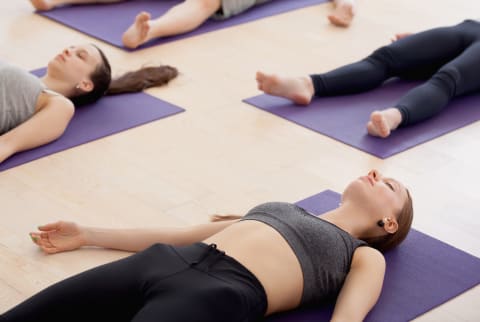Advertisement
How To Release Tension In Your Body With Yoga


Tension gets a bad rap—we see it as negative and restricting, even though in reality, it underpins so much of what makes our lives vibrant and meaningful. Muscular tension creates the stored energy we need to run fast, jump high, and even scamper up trees (if you're into that sort of thing). And excitement, attraction, anticipation, and passion are all highly pleasurable forms of emotional tension.
Tension is energy. It generates action. Tension itself is not a problem—but when it gets stuck, that's when bad things can start to happen. Think tight muscles that we haven't stretched out after our workouts, or the buildup of emotional tension we experience when we don't allow anger, resentment or anxiety to pass through us. Our aim should be to oscillate between periods of high and low tension—to maintain a healthy flow of energy and vitality—and one way to do that is to develop your yoga practice.
So with that said, here are my best tips for unwinding and striking balance during your next yoga session.
Start the class by paying close attention to your breath.
Notice its natural rhythm. The sensations of warmth and coolness at your nostrils as the air comes in and goes out of your body. The gentle rising and falling of your belly and chest. The sensations of expansion and contraction in your rib cage. Then try to consciously release any sense of contraction around your breathing. Keep your breaths smooth, steady, slow, deep, and relaxed. See how little effort you can exert on the process of breathing.
Tune in to areas where you notice you're holding tension.
As you start to move through the postures, try to feel out the places where you're holding tension. Are you gripping with your toes or tensing up your jaw? Do you scrunch up around your neck and shoulders or furrow your brow? Do you notice that you feel more or less tense when you practice at different times of day or when the circumstances of your life change? See if you can identify a map of contraction and relaxation in your body.
Throughout the sequence, try to strike a balance between stability and fluidity.
Aim for strength and spaciousness in the poses and grace and agility in your transitions. This takes presence and close attention to the breath. Exert yourself just enough to do your best in the pose, with the least amount of tension possible and an intention to remain struggle-free. Use your breath as a barometer. If you find yourself holding your breath or straining to breathe, you're pushing too hard—so back off a little on the intensity or take a break.
When you come into a stretch, be careful not to try to use force to increase the intensity.
Doing this will actually trigger your body's reflexes and cause your muscles to contract. Instead, deepen your breath, back a little way out of the stretch, and then drop a fraction deeper into the pose.
Take the time to do (and embrace) savasana.
Savasana is the ultimate tension-dissolving pose. As you're scanning your body for sensations, bring a gentle feeling of relaxation to any areas of lingering tightness. Buddhist meditation teacher Tara Brach guides her students to visualize the transition from ice to water, and water to gas. When you're relaxed, you have an increased perception of the subtler sensations in your body. Over time, this will allow you to notice a buildup of anger, anxiety, frustration, or disappointment earlier in the cycle and give you the opportunity to interrupt the momentum before it gets out of control.
If you feel tension in your body, whether physical, emotional, or both, yoga is one of the most effective and pleasurable ways to unwind yourself. It will help you to become aware of when and where you are holding on to tightness in your body. You will learn ways to breathe, stretch, and relax. And with this newfound spaciousness and freedom, your whole life becomes more vibrant and colorful.
Watch Next
Enjoy some of our favorite clips from classes
Enjoy some of our favorite clips from classes
What Is Meditation?
Mindfulness/Spirituality | Light Watkins
Box Breathing
Mindfulness/Spirituality | Gwen Dittmar
What Breathwork Can Address
Mindfulness/Spirituality | Gwen Dittmar
The 8 Limbs of Yoga - What is Asana?
Yoga | Caley Alyssa
Two Standing Postures to Open Up Tight Hips
Yoga | Caley Alyssa
How Plants Can Optimize Athletic Performance
Nutrition | Rich Roll
What to Eat Before a Workout
Nutrition | Rich Roll
How Ayurveda Helps Us Navigate Modern Life
Nutrition | Sahara Rose
Messages About Love & Relationships
Love & Relationships | Esther Perel
Love Languages
Love & Relationships | Esther Perel

















